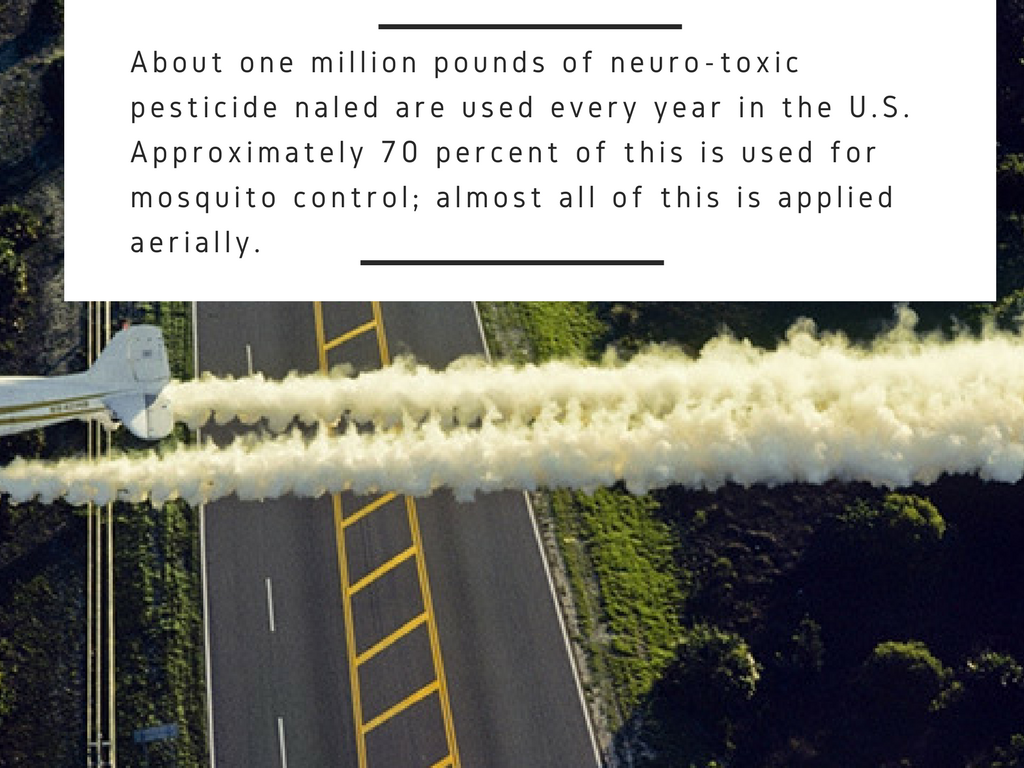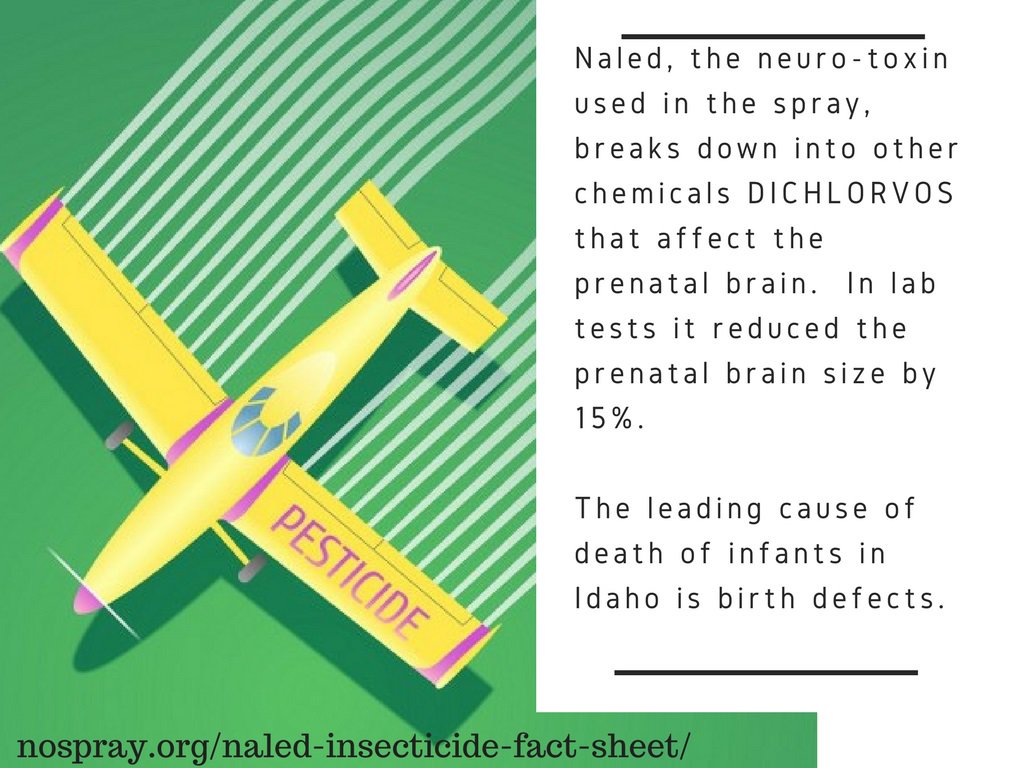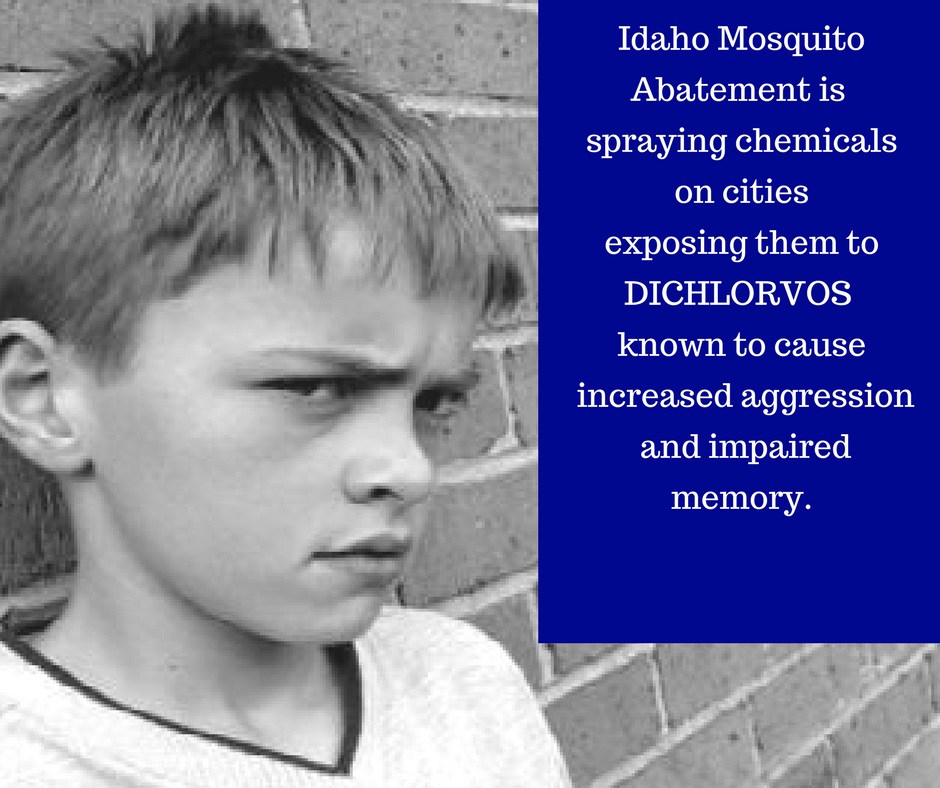West Nile Virus vs Naled Neurotoxin

NALED Insecticide Fact Sheet
Naled is an insecticide in the organophosphate pesticide family that is commonly used to kill adult (flying) mosquitoes.
Naled has been registered for use in the U.S. since 1959 and is sold under the brand name Dibrom. AMVAC Chemical Corporation has been the major manufacturer of NALED since 1998.
Use:
About one million pounds of naled are used every year in the U.S. Approximately 70 percent of this is used for mosquito control; almost all of this is applied aerially.

The remaining 30 percent is used in agriculture. Major agricultural uses are on cotton in California and Louisiana, on alfalfa in Idaho and Oregon, and on grapes in California.
Efficacy of Mosquito Treatments
The U.S. Centers for Disease Control and Prevention has written that “adulticiding, application of chemicals to kill adult mosquitoes by ground or aerial applications, is usually the least efficient mosquito control technique.
Naled is no exception. For example, researchers from the New York Department of Health showed that 11 years of naled spraying was “successful in achieving short-term reductions in mosquito abundance, but populations of the disease-carrying mosquito of concern “increased 15-fold over the 11 years of spraying.
Mode of Action
Like all organophosphate insecticides, NALED (DIBROM) Naled is an insecticide in the organophosphate pesticide family used primarily for mosquito control. Dibrom is a common brand name for naled products. About one million pounds are used annually in the U.S. Like all organophosphates, naled is toxic to the nervous system. Symptoms of exposure include headaches, nausea, and diarrhea. Naled is more toxic when exposure occurs by breathing contaminated air than through other kinds of exposure. In laboratory tests, naled exposure caused increased aggressiveness and a deterioration of memory and learning.
Naled’s breakdown product DICHLORVOS (another organophosphate insecticide) interferes with prenatal brain development. In laboratory animals, exposure for just 3 days during pregnancy when the brain is growing quickly reduced brain size 15 percent.

DICHLORVOS also causes cancer, according to the International Agency for Research on Carcinogens. In laboratory tests, it caused leukemia and pancreatic cancer. Two independent studies have shown that children exposed to household “no-pest” strips containing dichlorvos have a higher incidence of brain cancer than unexposed children.
Aerial applications of naled can drift up to one-half mile. According to the U.S. Environmental Protection Agency, naled is moderately to highly toxic to birds and fish. It also reduced egg production and hatching success in tests with birds and reduced growth in tests with juvenile fish. convulsions, paralysis, and death.
Breakdown Products
** Naled breaks down into dichlorvos **
DICHORVOS
another organophosphate insecticide, in animals and soil. THIS IS DANGEROUS!!!
Effects on Behavior
Exposure to naled has multiple effects on behavior. In a study conducted by naled’s manufacturer, naled caused reduced muscle strength, slow responses to stimulation, and reduced activity in rats.
These behavioral changes occurred at all but the lowest dose level tested in males and all dose levels tested in females, suggesting that females are more sensitive than males to naled poisoning.

Exposure to naled’s breakdown product dichlorvos causes increased aggression and impaired memory. The Indian biochemists mentioned above found that fighting aggression was increased about 5 times
Inert Ingredients
Like most pesticides, commercial naled-containing insecticides contain ingredients other than naled. Many of these ingredients, according to U.S. pesticide law, are called “inert.” Except for tests of acute effects, toxicology tests required for the registration of a pesticide are not conducted with the combination of ingredients found in commercial products.
Most inert ingredients are not identified on product labels, and little information about them is publicly available.
Symptoms of Exposure
Symptoms of exposure to naled and all organophosphate insecticides include headaches, muscle twitching, nausea, diarrhea, difficult breathing, naled kills insects by inhibiting acetylcholinesterase (AChE), an enzyme involved in the transmission of nerve impulses from one nerve cell to another. This causes a “jam” in the transmission system, resulting in restlessness,depression, seizures, and loss of consciousness.
Toxicity to the Nervous System
A symptom of exposure to naled that occurs at low doses (whether by breathing, through the skin, or orally) is inhibition of acetylcholinesterase (AChE).
In studies conducted by naled manufacturers, exposure of rats to naled in air at a dose of 0.3 milligrams per kilogram of body weight (mg/kg) per day for three weeks, skin exposures of 20 mg/kg per day for 4 weeks, and oral exposure of 10 mg/ kg per day for 4 weeks caused inhibition of AChE.
Long-term exposure also caused AChE inhibition; reduced AChE activity occurred in dogs exposed orally to 2 mg/kg per day for 1 year and in rats exposed orally to the same dose for 2 years.
In addition, the long-term study with dogs found that doses of 2 mg/kg per day also caused mineralization of the spinal cord.
Naled’s breakdown product dichlorvos inhibits the activity in rats of a nervous system enzyme called neuropathy target esterase.
In experiments conducted by biochemists at the Postgraduate Institute of Medical Education and Research (India), doses of 6 mg/kg per day reduced the enzyme’s activity by about 40 percent.
Inhibition of this enzyme causes partial paralysis of the hind legs followed by incoordination.
Toxicity Caused by Breathing Naled
Naled is more potent when exposure occurs through breathing than when exposure occurs through eating contaminated food or drinking contaminated water.
Toxicologists at the University of California found that inhalation was 20 times more toxic to rats than oral dosing (dosing through the mouth) of naled.
The U.S. Environmental Protection Agency (EPA) came to a similar conclusion based on tests submitted to the agency by naled’s manufacturer: the dose required to cause cholinesterase inhibition through inhalation exposure was less than 1/6 of the lowest oral dose causing the same effect.
An additional study by the University of California researchers mentioned above found that small droplets of naled (the size produced by ultra low volume sprayers often used in mosquito spraying) were about four times more acutely toxic than larger droplets.
Dibrom Concentrate
(EPA Registration No. 5481-480) contains the inert ingredient aromatic hydrocarbon solvent (Chemical Abstract Services number 64742-94-5), also called solvent naphtha.
This solvent contains two aromatic hydrocarbons, naphthalene and 1,2,4- trimethylbenzene. Dibrom 8 Emulsive (EPA Registration No. 5481-479) contains naphthalene. Dibrom 8 Miscible (EPA Registration No. 34704-351) contains solvents4 whose ingredients can include naphthalene and trimethylbenzene.
Naphthalene has been classified by EPA as a possible human carcinogen because it caused lung tumors in mice following inhalation.
Naphthalene exposure also causes headaches, restlessness, lethargy, nausea, diarrhea, and anemia.
Anemia in newborns can be caused by exposure during pregnancy.
1,2,4-trimethylbenzene is irritating to eyes and skin. It can depress the central nervous system and cause headache, fatigue, nausea, and anxiety. It has also caused asthmatic bronchitis.
Exposure to Naled’s Breakdown Product Increases Aggressiveness and Disrupts Learning
In laboratory animals, exposure to naled’s breakdown product dichlorvos causes more frequent fighting and hinders learning. Number of fighting episodes (per minute, with standard deviations) ore common among exposed rats than among unexposed ones.
Exposed animals also required more trials than unexposed ones to learn an avoidance behavior, indicating a “severe deterioration in their memory and learning functions.”
Eye and Skin Irritation
Naled is a “severe” eye irritant and is “corrosive” to skin. All three frequently used commercial Dibrom products pose similar hazards.
Labels of two of the products warn “causes irreversible eye and skin damage and the third states that it is “corrosive” and “causes eye damage and skin damage.” Skin irritation was documented by physicians soon after naled’s use in the U.S. began.
Effects on the Circulatory System
In a long-term feeding study conducted by naled’s manufacturer, naled caused anemia in dogs at all but the lowest dose level tested. Exposures of 2 mg/kg per day reduced the number of red blood cells and the amount of hemoglobin (the oxygen-carrying pigment) in the blood.20
Effects on Reproduction
Dichlorvos, naled’s breakdown product, interferes with prenatal brain development.
Biologists at the University of Oslo found that dosing guinea pigs with 15 mg/kg of dichlorvos twice daily for three days during pregnancy caused a significant (15 percent) decrease in the offspring’s brain size.
The guinea pigs were dosed with dichlorvos between the 40th and 50th day of their pregnancy, a time when the fetal brain is undergoing a growth spurt.
In addition, University of Michigan researchers showed that naled exposure causes delays in the development of rat embryos. For example, exposure of pregnant rats on the ninth day of their pregnancy caused a significant delay in the closing of the embryo’s neural tube.
Naled and dichlorvos can be passed from mothers to their offspring through nursing. German researchers found both insecticides in milk from cows that had been treated with naled.
Ability to Cause Genetic Damage (Mutagenicity)
Naled damaged bacteria’s genetic material in laboratory tests conducted by geneticists at Monash University (Australia)24 as well as biologists at Texas Tech University.
Naled’s breakdown product DICHLORVOS also causes genetic damage.
A team of Greek and Dutch scientists found that injections of dichlorvos at weekly intervals in mice caused a 3-fold increase in the number of mutations in liver cells.
A team of geneticists from the National Research Centre (Egypt) found that oral doses of dichlorvos given to mice, or feeding mice diclorvos-treated beans, increased the incidence of chromosome abnormalities in both spleen and sperm cells.
Ability to Cause Cancer (Carcinogenicity)
EPA classifies naled as a “Group E” chemical. Group E chemicals have demonstrated “evidence of noncarcinogenicity” in laboratory tests.
Naled’s breakdown product DICHLORVOS however, is classified as “possibly carcinogenic to humans,” with “sufficient evidence in experimental animals” for its carcinogenicity by the International Agency for Research on Carcinogens. The agency gave dichlorvos this classification because it caused forestomach tumors, leukemia, and pancreatic tumors in laborators tests with rats and mice.
In children, exposure to dichlorvos has been linked with increased cancer risks. Researchers at the University of North Carolina found an association between exposure to dichlorvos “no-pest” strips during pregnancy or during childhood and the incidence of three types of childhood cancer: leukemias, brain tumors, and lymphoma.
Missouri Department of Health researchers found similar results for childhood brain cancer.
Effects on the Immune System
Both naled and its breakdown product DICHLORVOS inhibited an enzyme in white blood cells called monocyte esterase, according to a study conducted by researchers at the Technicon Science Center.
Monocyte esterases are an “integral component”33 of the process by which white blood cells eliminate virus-infected cells from our bodies and monitor for precancerous cells.
Synergy
A study submitted to EPA by Shell Chemical Co. showed that “the toxic effects of naled were potentiated by co-administration of Ciodrin, malathion, and methyl parathion. All three are insecticides in the organophosphate family.
Special Susceptibility
Malnourished individuals may be particularly susceptible to naled poisoning. Researchers from the Institute of Hygiene and Occupational Health (Bulgaria) studied naled’s effects on rats that were fed a low-protein diet and found that naled was almost twice as toxic to them as it was to rats fed a normal diet. In addition, the rats fed a low-protein diet developed liver damage from their naled exposure.
Contamination of Food
The U.S. Department of Agriculture documented contamination of strawberries, peppers, and beans with naled’s breakdown product dichlorvos.
Water Contamination
Insecticides in naled’s chemical family, the organophosphates, are com-Malnutrition Increases Naled’s Toxicity Naled inhibits the activity of an immune system enzyme. It is also more toxic to malnourished animals than animals fed a normal diet.
Median lethal dose
(milligrams per kilogram of body weight in rats) mon contaminants of urban streams and rivers. However, neither naled or its breakdown product dichlorvos were included in the national water quality monitoring program currently being conducted by the U.S. Geological Survey.
This means that no systematic information is available about naled contamination of U.S. streams, rivers, or wells.
EPA also does not have monitoring data for naled or its breakdown products in ground or surface water.
Air Contamination
Naled can persist in air up to several days after treatment. University of California, Davis toxicologists measured both naled and its breakdown product dichlorvos in the air around a naledtreated orange grove for three days after application.
Drift
Aerial applications of naled drift (move from the target site during application) for significant distances. Entomologists from the University of Florida measured naled contamination 750 meters (2400 feet) downwind from sprayed areas. They suggest that nospray buffer zones greater than 750 meters in width “be placed around ecologically sensitive areas.
Effects on Beneficial Insects
Because it is a broad spectrum insecticide, it is not surprising that naled impacts beneficial insects, those that provide important economic benefits to farmers. In a study submitted as part of naled’s registration process, naled was “highly toxic”42 to honey bees. Follow-up studies found that this toxicity decreased rapidly during the first day after treatment.42 Naled’s toxicity to other species of bees (alfalfa leafcutting bees and alkali bees) is more persistent than for honey bees.43 It can “mimic long residual [persistent] materials,” reducing leafcutting bee numbers 48 hours after treatment.
Parasitoid wasps (wasps that lay their eggs in juvenile stages of other insects, which then are killed as the wasps hatch and develop) can also be poisoned by low-level exposure to naled.
Naled (and Dichlorvos)Inhibit the Immune System
According to U.S. Department of Agriculture researchers, a wasp that parasitizes fruit flies was killed by a naled and protein bait mixture designed to kill fruit flies.
Naled is also highly toxic to a predatory mite.
A University of Florida zoologist studied areas in Florida where regular mosquito spraying occurred with Dibrom and another insecticide. He found a “major loss” in insect diversity in sprayed sites. Wasps showed “some of the most dramatic drops in species diversity.”47 Scale insects, whose populations are normally controlled by parasitic wasps, increased.
Effects on Birds
According to EPA, naled is moderately to highly toxic to birds. The most sensitive species tested by naled’s manufacturer during the registration process was the Canada goose, killed by 37 mg/kg of naled.
According to tests conducted by naled’s manufacturer, this insecticide also affects bird reproduction. Mallard ducks eating food treated with naled laid fewer eggs, produced fewer viable eggs, and hatched fewer ducklings than unexposed mallards.
Effects on Fish
According to EPA, naled is very highly toxic to lake trout; highly toxic to rainbow trout, cutthroat trout, and catfish; and moderately toxic to sunfish, minnow, and bass. The most sensitive species in tests submitted to EPA by naled’s manufacturer was lake trout, with an LC50 (median lethal concentration; the dose required to kill 50 percent of test animals) of 87 parts per billion (ppb). Naled also causes effects on fish other than death. In a test conducted by naled’s manufacturer, a concentration of 15 ppb impaired the growth of fathead minnows
Effects on Other Aquatic Animals
Ecologically important insects are killed by naled. According to a naled manufacturer, a concentration of 8 ppb kills stoneflies.50 Research conducted by the Arctic Health Research Center (Alaska) showed that water striders were killed 300 feet from a naled fogger.
Stoneflies are important nutrient cyclers in streams and water striders are scavengers and predators. Aquatic arthropods are also impacted by naled. Waterfleas are killed by less than 0.5 ppb of naled in tests conducted by naled’s manufacturer, and less than 0.2 ppb disrupts waterflea growth. Shrimp are killed by less than 10 ppb. According to EPA, naled is “very highly toxic” to oysters. Sea urchins are also sensitive to naled exposure. University of Miami researchers showed that concentrations of less than 4 ppb disrupt normal development of embryos.
Effects on Endangered Species
Evaluations by both EPA and the U.S. Fish and Wildlife Service have concluded that use of naled puts endangered mammals, fish, mussels, and other species at risk. In addition, there is field evidence of naled’s hazards for endangered species.
Dibrom spraying (along with spraying of another insecticide) was “directly correlated with the precipitous decline in the Schaus Swallowtail populations on Key Largo [FL], according to a University of Florida zoologist. This swallowtail is listed as an endangered species under both Florida and federal law.
A University of Florida entomologist studying a different rare butterfly, the Florida lacewing, found higher populations in unsprayed areas than in sprayed areas. (See Figure 7.) He concluded that “it is likely that chemical applications play an important role in affecting the population size and behavior of these species.
Effects on Plants
Insecticides are typically not expected to damage plants. However, University of California researchers showed that naled treatment caused brown lesions in celery and bronzing of strawberries.The strawberry damage was accompanied by reduced photosynthesis (using sunlight to produce sugars) and closing of leaf openings (stomata).60 Brazilian researchers found that naled also “drastically reduced” tomato pollen germination. In aquatic plants, naled reduces photosynthesis. In laboratory tests, a naled concentration of 1 ppm reduced photosynthesis by estuary algae by over 50 percent.
*********************************
http://www.pesticide.org/naled.pdf
http://www.panna.org/
http://www.panna.org/resources/gpc/gpc_200212.12.3.14.dv.html




